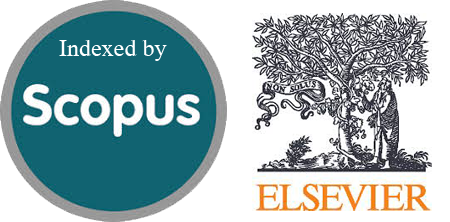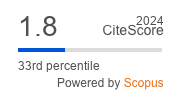Temu Kembali Kemiripan Motif Citra Tenun Menggunakan Transformasi Wavelet Diskrit Dan GLCM
Abstract
Indonesia is a country with cultural diversity. One of the famous cultural heritages in Indonesia is Woven Fabrics. East Nusa Tenggara Province, especially South Central Timor, is an area that also produces weaving. There are 3 types of woven fabric motifs, namely the Buna, Lotis, and Futus motifs which were inherited from their ancestors. Woven cloth is unique because it is made through a ritual process and is used for traditional ceremonies, weddings, funerals, and so on. However, along with the development of technology, ordinary people increasingly forget the motifs of woven fabrics and have difficulty distinguishing the motifs. The function of this research is to improve the performance of previous studies in the process of finding the similarity of weaving image motifs using discrete wavelet transforms and GLCM. The results are known, calculations using a confusion matrix on discrete wavelet transformation feature extraction and GLCM, comparisons on discrete wavelet transformations produce an accuracy rate of 70% Minkowski matrix, 60% Manhattan matrix, 60% Canberra matrix, 20% Euclidean matrix. Comparison of feature extraction calculations on GLCM produces an average quality of the Minkowski matrix of 90% and the lowest level of accuracy on the Euclidean, Manhattan, and Canberra matrices of 80%.
Downloads
References
[2] S. Nasional, S. Dan, and T. Fst, “Implementasi Principal Component Analysis ( Pca ) Untuk Temu Kembali Citra Motif Kain Tenun Ntt Berdasarkan Warna Dan Tekstur Content Based Image Retrieval( CBIR ) Statistika Warna,” pp. 317–323, 2019, doi: https://conference.undana.ac.id/sainstek/article/view/58.
[3] P. W. Sudarmadji, “Aplikasi Berbasis E-Commerce Sebagai Media Promosi Tenun Ikat Kabupaten Timor Tengah Selatan,” J. Ilm. Flash, vol. 2, no. 2, p. 124, Dec. 2016, doi: 10.32511/jiflash.v2i2.33.
[4] A. Regiaswuri and D. R. Sulistyaningrum, “Penemuan Kembali Citra Tenun Dengan Kemiripan Motif Menggunakan Transformasi Wavelet Diskrit,” 2017, doi: https://repository.its.ac.id/id/eprint/3109.
[5] Y. Arum Sari and C. Dewi, “Sistem Temu Kembali Citra Lubang Jalan Aspal Berdasarkan Tingkat Kerusakan Menggunakan Ekstraksi Fitur Gray Level Co-occurrence Matrix Improved Linear Regression View project IT for Agriculture View project,” J. Pengemb. Teknol. Inf. dan Ilmu Komput., vol. 2, no. 10, pp. 3811–3821, 2018, [Online]. Available: http://j-ptiik.ub.ac.id.
[6] A. F. Ahsani, Y. A. Sari, and P. P. Adikara, “Temu Kembali Citra Makanan Menggunakan Ekstraksi Fitur Gray Level Co-Occurrence Matrix Dan CIE L* A* B* Color Moments Untuk Pencarian Resep …,” … Teknol. Inf. dan Ilmu …, vol. 3, no. 3, pp. 2261–2268, 2019, doi: https://j-ptiik.ub.ac.id/index.php/j-ptiik/article/view/4635.
[7] N. Nurhalimah, I. G. P. Suta Wijaya, and F. Bimantoro, “Klasifikasi Kain Songket Lombok Berdasarkan Fitur GLCM dan Moment Invariant Dengan Teknik Pengklasifikasian Linear Discriminant Analysis (LDA),” J. Teknol. Informasi, Komputer, dan Apl. (JTIKA ), vol. 2, no. 2, pp. 173–183, 2020, doi: 10.29303/jtika.v2i2.98.
[8] B. Imran and M. M. Efendi, “The Implementation Of Extraction Feature Using Glcm And Back-Propagation Artificial Neural Network To Clasify Lombok Songket Woven Cloth,” J. Techno Nusa Mandiri, vol. 17, no. 2, pp. 131–136, Sep. 2020, doi: 10.33480/techno.v17i2.1680.
[9] E. M. Adams Jonemaro and D. S. Rusdianto, “Sistem Temu Kembali Citra Berbasis Konten Menggunakan Haar Wavelet Transform Dan K-Means Clustering,” J. Teknol. Inf. dan Ilmu Komput., vol. 3, no. 1, p. 27, Mar. 2016, doi: 10.25126/jtiik.201631152.
[10] Kevin, J. Hendryli, and D. E. Herwindiati, “Klasifikasi kain tenun berdasarkan tekstur & warna dengan metode K-NN,” J. Comput. Sci. Inf. Syst., vol. 3, no. 2, pp. 85–95, 2019, doi: 10.15640/jcsit.
[11] A. Y. Rahman, “Klasifikasi Citra Burung Lovebird Menggunakan Decision Tree dengan Empat Jenis Evaluasi,” J. RESTI (Rekayasa Sist. dan Teknol. Informasi), vol. 5, no. 4, pp. 688–696, Aug. 2021, doi: 10.29207/resti.v5i4.3210.
[12] M. Nishom, “Perbandingan Akurasi Euclidean Distance, Minkowski Distance, dan Manhattan Distance pada Algoritma K-Means Clustering berbasis Chi-Square,” J. Inform. J. Pengemb. IT, vol. 4, no. 1, pp. 20–24, 2019, doi: 10.30591/jpit.v4i1.1253.
[13] N. Chahal, M. Pippal, and S. Chaudhury, “Depth estimation from single image using machine learning techniques,” ACM Int. Conf. Proceeding Ser., 2016, doi: 10.1145/3009977.3010019.
[14] N. Nurhalimah, I. G. P. Suta Wijaya, and F. Bimantoro, “Klasifikasi Kain Songket Lombok Berdasarkan Fitur GLCM dan Moment Invariant Dengan Teknik Pengklasifikasian Linear Discriminant Analysis (LDA),” J. Teknol. Informasi, Komputer, dan Apl. (JTIKA ), vol. 2, no. 2, pp. 173–183, Sep. 2020, doi: 10.29303/jtika.v2i2.98.
[15] M. E. Al Rivan, N. Rachmat, and M. R. Ayustin, “Klasifikasi Jenis Kacang-Kacangan Berdasarkan Tekstur Menggunakan Jaringan Syaraf Tiruan,” J. Komput. Terap., vol. 6, no. 1, pp. 89–98, 2020, doi: 10.35143/jkt.v6i1.3546.
[16] H. Maghfirah, F. Arnia, and K. Munadi, “Temu Kembali Citra Busana Muslimah Berdasarkan Bentuk Menggunakan Curvature Scale Space (CSS),” J. Nas. Tek. Elektro dan Teknol. Inf., vol. 6, no. 1, 2017, doi: 10.22146/jnteti.v6i1.297.
Copyright (c) 2021 Jurnal RESTI (Rekayasa Sistem dan Teknologi Informasi)

This work is licensed under a Creative Commons Attribution 4.0 International License.
Copyright in each article belongs to the author
- The author acknowledges that the RESTI Journal (System Engineering and Information Technology) is the first publisher to publish with a license Creative Commons Attribution 4.0 International License.
- Authors can enter writing separately, arrange the non-exclusive distribution of manuscripts that have been published in this journal into other versions (eg sent to the author's institutional repository, publication in a book, etc.), by acknowledging that the manuscript has been published for the first time in the RESTI (Rekayasa Sistem dan Teknologi Informasi) journal ;








